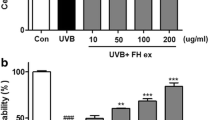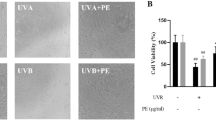Abstract
Ultraviolet B (UVB) (290–320 nm) is the foremost cause of photoaging, sunburn, wrinkles and skin cancer. Photoprotection against harmful UVB radiation is essential through various means including the use of skincare products. The seaweed polysaccharide carrageenan is widely used as an excipient in cosmetics and skincare products. However, its effects on normal skin keratinocytes or potential use as a photoprotective agent have yet to be established. The primary aim of this study was to assess the cytotoxic, photoprotective and antioxdative effects of carrageenan in UVB-induced immortalised normal human keratinocytes (HaCaT cells). Results showed that the percentage of cell viability decreased linearly with increasing UVB doses from 10, 50, 100, 222 to 1,000 mJ cm−2. Four isomers of carrageenan, namely iota 2 [ι (ІІ)], iota 5 [ι (V)], lambda (λ) and kappa (κ) carrageenan were used in this study. Vitamin E was used as a positive control. In terms of cytotoxicity, the CD50 of kappa carrageenan was ~200 μg mL−1 while for the other isomers, the values ranged from 122 to 162 μg mL−1. Carrageenan showed significant protection against detrimental effects of UVB-induced cell killing and reactive oxygen species (ROS) release based on 3-(4,5-dimethylthiazol-2-yl)-2,5-diphenyltetrazolium bromide (MTT) and 2′,7′-dichlorfluorescein-diacetate (DCFH-DA) assays, respectively. Carrageenan was also able to quench 1,1-diphenyl-2-picrylhydrazyl (DPPH) free radicals. The ability to protect against UVB suggests that carrageenan has potential application as a photoprotective agent in addition to just being used as an excipient.






Similar content being viewed by others
References
Abad LV, Relleve LS, Racadio CD, Aranilla CT, De la Rosa AM (2013) Antioxidant activity potential of gamma irradiated carrageenan. Appl Radiat Isot 79:73–79
Ajisaka K, Agawa S, Nagumo S, Kurato K, Yokoyama T, Arai K, Miyazaki T (2009) Evaluation and comparison of the antioxidative potency of various carbohydrates using different methods. J Agric Food Chem 57:3102–3107
Ale MT, Maruyama H, Tamauchi H, Mikkelsen JD, Meyer AS (2011) Fucose-containing sulfated polysaccharides from brown seaweeds inhibit proliferation of melanoma cells and induce apoptosis by activation of caspase-3 in vitro. Mar Drugs 9:2605–2621
Ananthaswamy HN, Pierceall WE (1992) Molecular alterations in human skin tumors. Prog Clin Biol Res 376:61–84
Battin EE, Brumaghim JL (2009) Antioxidant activity of sulfur and selenium: a review of reactive oxygen species scavenging, glutathione peroxidase, and metal-binding antioxidant mechanisms. Cell Biochem Biophys 55:1–23
Baumann L (2009) Nutrition and the skin. In: Baumann L (ed) Cosmetic dermatology: principles and practice, 2nd edn. McGraw-Hill Professional, NY, pp 45–62
Benard C, Cultrone A, Michel C, Rosales C, Segain JP, Lahaye M, Blottière HM (2010) Degraded carrageenan causing colitis in rats induces TNF secretion and ICAM-1 upregulation in monocytes through NF-κB activation. PLoS ONE 5(1):e8666
Buettner GR (1993) The pecking order of free radicals and antioxidants: lipid peroxidation, alphatocopherol, and ascorbate. Arch Biochem Biophys 300(2):535–543
Bowden GT (2004) Prevention of non-melanoma skin cancer by targeting ultraviolet-B-light signalling. Nat Rev Cancer 4:23–35
Campo VL, Kawano DF, Silva DBD Jr, Carvalho I (2009) Carrageenans: biological properties, chemical modifications and structural analysis—a review. Carbohydr Polym 77:167–180
Caricchio R, McPhie L, Cohen PL (2003) Ultraviolet B radiation-induced cell death: critical role of ultraviolet dose in inflammation and lupus autoantigen redistribution. J Immunol 171:5778–5786
Choi K, Kim J, Kim GW, Choi C (2009) Oxidative stress-induced necrotic cell death via mitochondria-dependent burst of reactive oxygen species. Curr Neurovasc Res 6:213–222
Cleaver JE, Crowley E (2002) UV damage, DNA repair and skin carcinogenesis. Front Biosci 7:1024–1043
Cooke MS, Evans MD, Dizdaroglu M, Lunec J (2003) Oxidative DNA damage: mechanisms, mutation, and disease. FASEB J 17:1195–1214
Coombe DR, Parish CR, Ramshaw IA, Snowden JM (1987) Analysis of the inhibition of tumour metastasis by sulphated polysaccharides. Int J Cancer 39:82–88
de Gruijl FR (2002) Photocarcinogenesis: UVA vs. UVB radiation. Skin Pharmacol Appl Ski Physiol 15:316–320
de Souza MCR, Marques CT, Dore CMG, da Silva FRF, Rocha HAO, Leite EL (2007) Antioxidant activities of sulfated polysaccharides from brown and red seaweeds. J Appl Phycol 19:153–160
Fuchs J, Weber S, Podda M, Groth N, Herrling T, Packer L, Kaufmann R (2003) HPLC analysis of vitamin E isoforms in human epidermis: correlation with minimal erythema dose and free radical scavenging activity. Free Radic Biol Med 34:330–336
Goihman-Yahr M (1996) Skin photoaging: an outlook. Clin Dermatol 14:153–160
Gonçalves AG, Ducatti DR, Duarte MER, Noseada MD (2002) Sulfated and pyruvylated disaccharide alditols obtained from a red seaweed galactan: ESIMS and NMR approaches. Carbohydr Res 337:2443–2453
Grassauer A, Weinmuellner R, Meier C, Pretsch A, Prieschl-Grassauer E, Unger H (2008) Iota-Carrageenan is a potent inhibitor of rhinovirus infection. Virol J 5:107. doi:10.1186/1743-422X-5-107
Grzanka D, Domaniewski J, Grzanka A, Zuryn A (2006) Ultraviolet radiation (UV) induces reorganization of actin cytoskeleton in CHOAA8 cells. Neoplasma 53:328–332
Haijin M, Xiaolu J, Huashi G (2003) A κ-carrageenan derived oligosaccharide prepared by enzymatic degradation containing anti-tumor activity. J Appl Phycol 15:297–303
Hart PH, Grimbaldeston MA, Finlay-Jones JJ (2001) Sunlight, immunosuppression and skin cancer: role of histamine and mast cells. Clin Exp Pharmacol Physiol 28:1–8
Jonason AS, Kunala S, Price GJ, Restifo RJ, Spinelli HM, Persing JA, Leffell DJ, Tarone RE, Brash DE (1996) Frequent clones of p53-mutated keratinocytes in normal human skin. Proc Natl Acad Sci U S A 93:14025–14029
Kalitnik AA, Barabanova AO, Nagorskaya VP, Reunov AV, Glazunov VP, Solov'eva TF, Yermak IM (2013) Low molecular weight derivatives of different carrageenan types and their antiviral activity. J Appl Phycol 25:65–72
Katiyar SK, Afaq F, Azizuddin K, Mukhtar H (2001) Inhibition of UVB-induced oxidative stress-mediated phosphorylation of mitogen-activated protein kinase signaling pathways in cultured human epidermal keratinocytes by green tea polyphenol (−)-epigallocatechin-3-gallate. Toxicol Appl Pharmacol 176:110–117
Lee RE (2008) Phycology. Cambridge University Press, Cambridge, England
Long AC, Colitz CM, Bomser JA (2004) Apoptotic and necrotic mechanisms of stress-induced human lens epithelial cell death. Exp Biol Med 229:1072–1080
Mammone T, Gan D, Collins D, Lockshin RA, Marenus K, Maes D (2000) Successful separation of apoptosis and necrosis pathways in HaCaT keratinocyte cells induced by UVB irradiation. Cell Biol Toxicol 16:293–302
Matsui MS, Muizzuddin N, Arad S, Marenus K (2003) Sulfated polysaccharides from red microalgae have antiinflammatory properties in vitro and in vivo. Appl Biochem Biotechnol 104:13–22
Michel G, Nyval-Collen P, Barbeyron T, Czjzek M, Helbert W (2006) Bioconversion of red seaweed galactans: a focus on bacterial agarases and carrageenases. Appl Microbiol Biotechnol 71:23–33
Necas J, Bartosikova L (2013) Carrageenan: a review. Vet Med 58:187–205
Packer L, Witt EH, Tritschler HJ (1995) Alpha-Lipoic acid as a biological antioxidant. Free Radic Biol Med 19:227–250
Packer L, Weber SU, Rimbach G (2001) Molecular aspects of alpha-tocotrienol antioxidant action and cell signalling. J Nutr 131:369S–373S
Park LJ, Ju SM, Song HY, Lee JA, Yang MY, Kang YH, Kwon HJ, Kim TY, Choi SY, Park J (2006) The enhanced monocyte adhesiveness after UVB exposure requires ROS and NF-kappaB signaling in human keratinocyte. J Biochem Mol Biol 39:618–625
Reagan-Shaw S, Breur J, Ahmad N (2006) Enhancement of UVB radiation-mediated apoptosis by sanguinarine in HaCaT human immortalized keratinocytes. Mol Cancer Ther 5:418–429
Ren SW, Li J, Wang W, Guan HS (2010) Protective effects of κ- ca3000 +CP against ultraviolet-induced damage in HaCaT and MEF cells. J Photochem Photobiol B 101:22–30
Sander CS, Chang H, Hamm F, Elsner P, Thiele JJ (2004) Role of oxidative stress and the antioxidant network in cutaneous carcinogenesis. Int J Dermatol 43:326–335
Sarasin A (1999) The molecular pathways of ultraviolet-induced carcinogenesis. Mutat Res 428:5–10
Satheeshkumar D, KottaiMuthu A, Anton Smith A, Manavalan R (2010) In vitro antioxidant activity of various extracts of whole plant of Mucuna pruriens (Linn). Int J PharmTechnol Res 2:2063–2070
Seol KH, Lim DG, Jang A, Jo C, Lee M (2009) Antimicrobial effect of κ-carrageenan-based edible film containing ovotransferrin in fresh chicken breast stored at 5 °C. Meat Sci 83:479–483
Schmid D, Schürch C, Zülli F (2006) Mycosporine-like amino acids from red algae protect against premature skin-aging. Mibelle AG Biochemistry, Bolimattstrasse. Euro Cosmetics 9:1–4
Schwarz A, Bhardwaj R, Aragane Y, Mahnke K, Riemann H, Metze D, Luger TA, Schwarz T (1995) Ultraviolet-B-induced apoptosis of keratinocytes: evidence for partial involvement of tumor necrosis factor-alpha in the formation of sunburn cells. J Investig Dermatol 104:922–927
Sokolova EV, Barabanova AO, Bogdanovich RN, Khomenko VA, Solov'eva TF, Yermak IM (2011) In vitro antioxidant properties of red algal polysaccharides. Biomed Prevent Nutr 1:161–167
Sokolova EV, Barabanova AO, Homenko VA, Solov'eva TF, Bogdanovich RN, Yermak IM (2010) In vitro and Ex vivo studies of antioxidant activity of carrageenans, sulfated polysaccharides from red algae. Bull Exp Biol Med 150:426–428
Spieler R (2002) Seaweed compound's anti-HIV efficacy will be tested in southern Africa. Lancet 359:1675
Sun T, Tao H, Xie J, Zhang S, Xu X (2010) Degradation and antioxidant activity of κ-carrageenans. J Appl Polym Sci 117:194–199
Thomson AW, Horne CH (1976) Toxicity of various carrageenans in the mouse. Br J Exp Pathol 57:455–459
Wan XS, Zhou Z, Kennedy AR (2003) Adaptation of the dichlorofluorescein assay for detection of radiation-induced oxidative stress in cultured cells. Radiat Res 160:622–630
Watt J, Marcus R (1969) Ulcerative colitis in the guinea-pig caused by seaweed extract. J Pharm Pharmacol 21:187S–188S
WHO/FAO (2008) Safety evaluation of certain food additives and contaminants. WHO Food Additives Series 59. http://www.inchem.org/documents/jecfa/jecmono/v59je01.pdf (accessed 22 September 2013)
Yoshitaka U, Toshio O, Yasunori G, Iwao A, Mikio N, Tamio M (2001) A method for average molecular weight measurement of carrageenan by GPC/ICP-AES method. Jap J Food Chem 8:33–43
Young AR (1990) Cumulative effects of ultraviolet radiation on the skin: cancer and photoaging. Semin Dermatol 9:25–31
Yuan H, Song J, Zhang W, Li X, Li N, Gao X (2006) Antioxidant activity and cytoprotective effect of kappa-carrageenan oligosaccharides and their different derivatives. Bioorg Med Chem Lett 16:1329–1334
Yuan YV (2007) Marine algal constituents. In: Barrow C, Shahidi F (eds) Marine nutraceuticals and functional foods. CRC Woodhead Press, Cambridge, pp 259–296
Zhou G, Sun Y, Xin H, Zhang Y, Li Z, Xu Z (2004) In vivo antitumor and immunomodulation activities of different molecular weight lambda carrageenans from Chondrus ocellatus. Pharmacol Res 50:47–53
Acknowledgments
This study was funded by the Fundamental Research Grant Scheme (FRGS) (FRGS/2/2010/SG/IMU/02/2) from the Ministry of Higher Education, Malaysia.
Author information
Authors and Affiliations
Corresponding author
Rights and permissions
About this article
Cite this article
Thevanayagam, H., Mohamed, S.M. & Chu, WL. Assessment of UVB-photoprotective and antioxidative activities of carrageenan in keratinocytes. J Appl Phycol 26, 1813–1821 (2014). https://doi.org/10.1007/s10811-013-0207-0
Received:
Revised:
Accepted:
Published:
Issue Date:
DOI: https://doi.org/10.1007/s10811-013-0207-0




